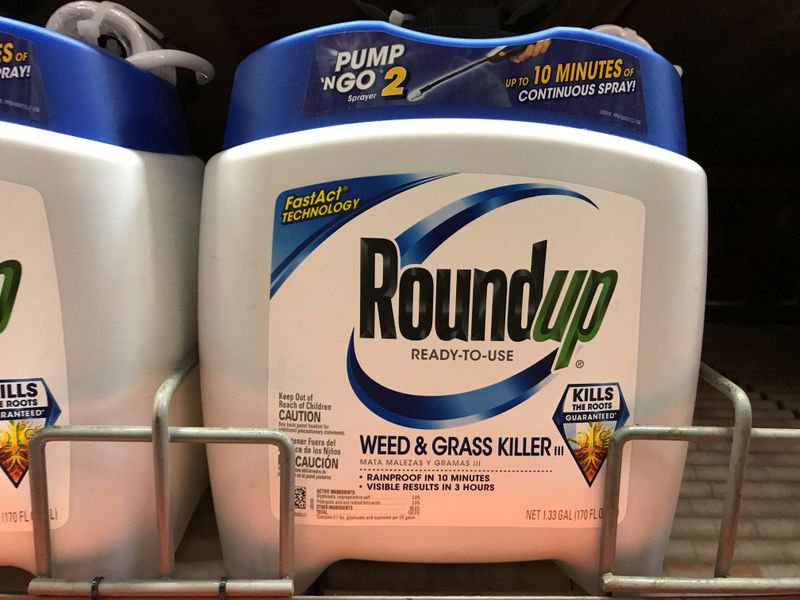By Tina Bellon
(Reuters) - Bayer AG (DE:BAYGn) is in mediation to potentially settle thousands of U.S. lawsuits claiming that the company's Roundup weed killer causes cancer, but some legal experts said the cases raises novel questions that may prevent an easy settlement.
More than 42,700 plaintiffs claim Roundup causes a type of cancer called non-Hodgkin's lymphoma.
Bayer to date has lost three U.S. jury trials in the Roundup litigation. The company is appealing or has vowed to appeal the decisions, saying Roundup and its active ingredient glyphosate are not carcinogenic and safe for human use.
Legal experts outlined several obstacles the parties may face on the path towards settlement.
WHY IS THE ROUNDUP LITIGATION DIFFERENT FROM OTHER PRODUCT CASES?
Settlements involving drugs, medical devices or consumer goods often result in the addition of a warning label, a recall or the outright discontinuance of a product. Those steps generally close the door to future lawsuits, making settlement costs and risks predictable.
Bayer has never publicly considered pulling Roundup off the market. The company in June announced a $5.6 billion investment to research and develop a glyphosate alternative.
Bayer unit Monsanto (NYSE:MON) began selling Roundup in 1974 and while the formulation is no longer patent-protected, Roundup remains widely available today. Bayer has repeatedly said Roundup is safe and important to farmers who use the herbicide in combination with the company's genetically modified seeds
Non-Hodgkin's lymphoma on average can take up to 10 years to emerge, increasing the likelihood of claims being filed after the litigation has settled. Product liability settlements generally include a cut-off date for future claimants and need to be properly funded for a court to approve the agreement.
As long as the product continues to be sold without changes to the label, plaintiffs may continue to file lawsuits, said Elizabeth Burch, a law professor at the University of Georgia.
COULD BAYER ADD A CANCER WARNING?
Plaintiffs lawyers, who claim the company manipulated the science, told Reuters they would insist on a cancer warning label as part of any Roundup settlement.
Such a warning has been rejected by the U.S. Environmental Protection Agency, which regulates pesticides and repeatedly has found glyphosate to be safe.
The agency said it has finished a regulatory review that found glyphosate is not a carcinogen.
In a filing to a federal appeals court, which hears one of the appeals to a jury verdict, the EPA and the U.S. Justice Department backed Bayer and said it was unlawful for manufacturers to make label claims that differ from EPA approval.
David Noll, a professor at Rutgers Law School, said adding a cancer warning over a regulator's explicit opposition presented unchartered legal territory.
HOW COULD BAYER SETTLE THE ROUNDUP LITIGATION?
To settle product liability litigation, companies generally set up a fund and the parties define criteria that current and future claimants must fulfill to receive compensation.
In the Roundup litigation, claimants could be divided into different groups depending on the frequency of their Roundup use and disease severity and length.
But Adam Zimmerman, a law professor at Loyola Law School, said defining those groups is complicated by the lack of a signature disease associated with Roundup, making it difficult to predict Bayer's liability.
For example, in asbestos litigation, mesothelioma, a rare tissue cancer, was recognized as a signature disease caused by exposure to asbestos fibers.
Doctors recognize several risk factors leading to non-Hodgkin's lymphoma, but the disease is largely considered to have no known cause. Around 74,000 people in the United States are expected to be diagnosed with the disease in 2019, according to the American Cancer Society.

Settling claims might not preclude future lawsuits if the fund runs out of money. In the Agent Orange litigation, Vietnam War veterans were allowed to sue chemical companies decades after a settlement was reached because the compensation fund was depleted by the time they developed their diseases.